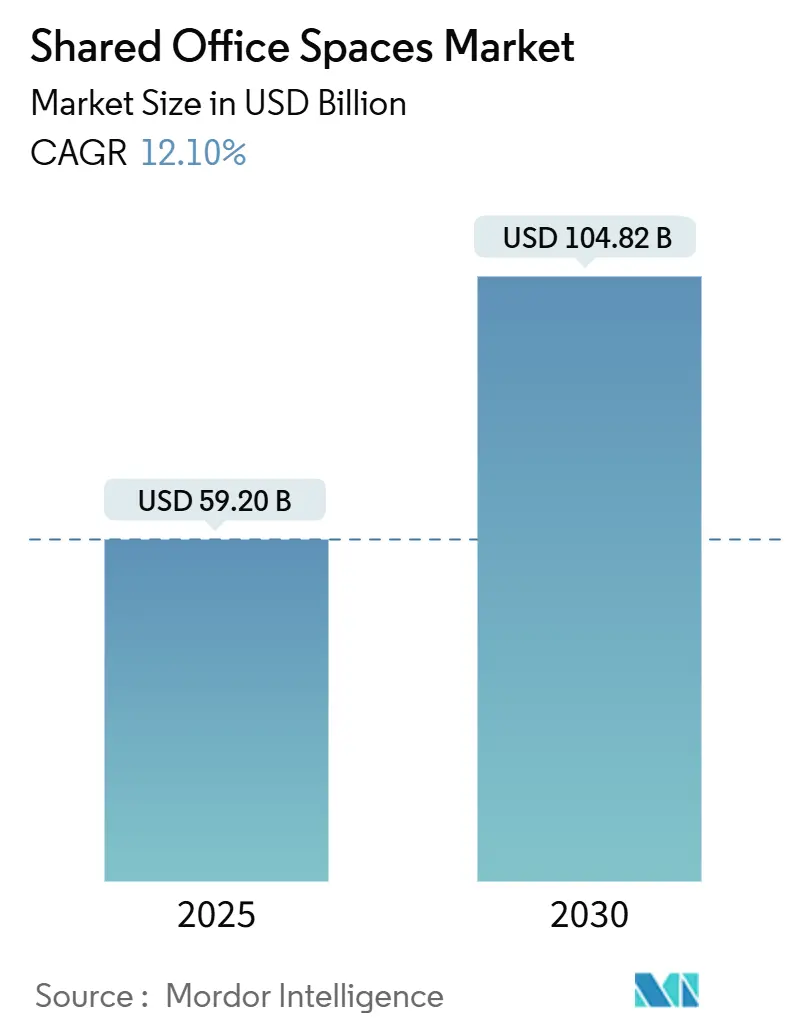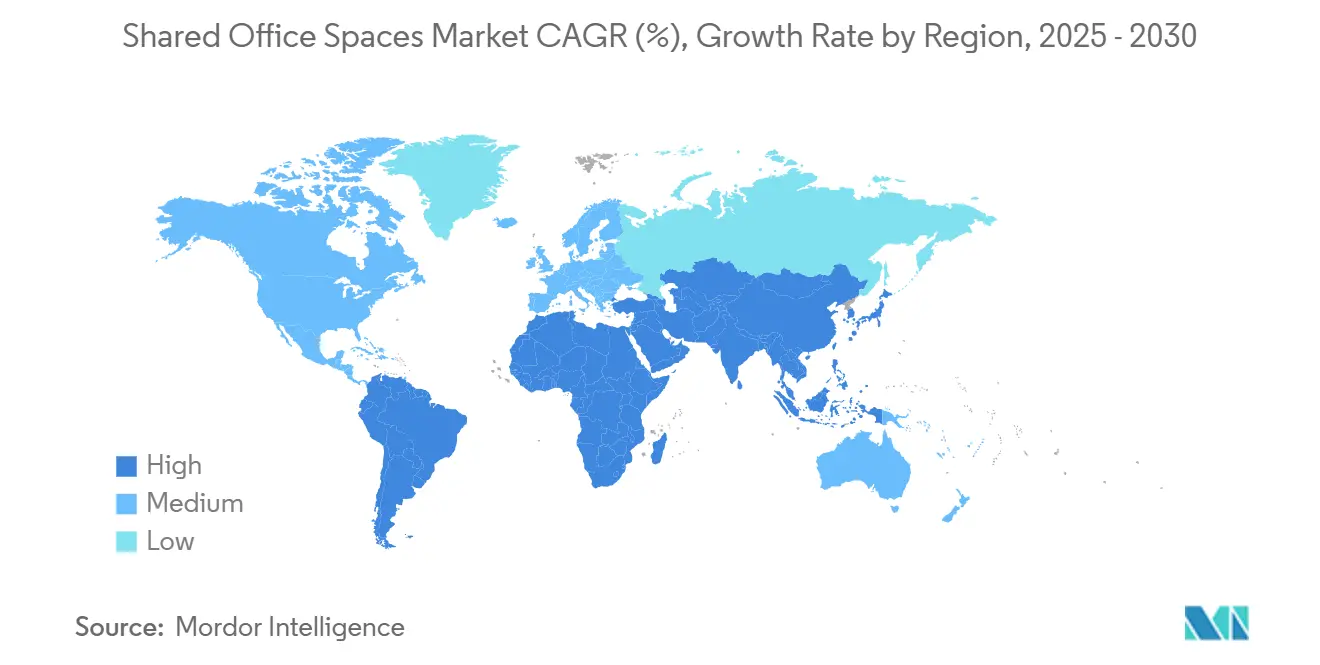Shared Office Spaces Market Size and Share

Shared Office Spaces Market Analysis by Mordor Intelligence
The shared office spaces market size stood at USD 59.20 billion in 2025 and is forecast to reach USD 104.82 billion by 2030, advancing at a 12.1% CAGR. Rapid enterprise adoption of hybrid work, investor appetite for asset-light models, and steady expansion into secondary cities fuel this momentum. Operators are pivoting toward revenue-sharing partnerships that limit lease liabilities while extending network reach. Technology investments in wellness-certified, data-driven spaces deepen client stickiness, even as oversupply in legacy urban cores pressures margins. Asia-Pacific drives headline growth, while South America offers the steepest runway for new entrants courting first-time flexible-workspace users.
Key Report Takeaways
- By type, co-working spaces captured 59.8% of the shared office spaces market share in 2024, whereas hybrid and virtual office solutions are projected to compound at a 12.88% CAGR through 2030.
- By sector, information technology led with 36.1% revenue share in 2024; other services—including retail, life sciences, energy, and legal—are set to expand at a 13.12% CAGR to 2030.
- By end use, the enterprise segment accounted for a 58.1% share of the shared office spaces market size in 2024, while start-ups and others will grow the fastest at 13.31% CAGR through 2030.
- By geography, Asia-Pacific dominated with 37.4% revenue in 2024; South America is forecast to deliver a 13.55% CAGR between 2025-2030.
Global Shared Office Spaces Market Trends and Insights
Drivers Impact Analysis
| Drivers | (~) % Impact on CAGR Forecast | Geographic Relevance | Impact Timeline |
|---|---|---|---|
| Rapid adoption of hybrid and flexible work models across corporates and SMEs | +3.2% | Global, with strongest impact in North America & Europe | Short term (≤ 2 years) |
| Expansion of global co-working operators into emerging and secondary cities | +2.8% | Asia-Pacific core, spill-over to Latin America and Africa | Medium term (2-4 years) |
| Rising demand from start-ups, freelancers, and digital nomads | +2.1% | Global, concentrated in tech hubs and nomad-friendly jurisdictions | Medium term (2-4 years) |
| Investor interest in shared office portfolios as resilient asset class | +1.9% | North America & EU, expanding to APAC | Long term (≥ 4 years) |
| Increasing tenant preference for wellness-certified, tech-enabled, and community-driven spaces | +1.5% | Global, led by developed markets | Long term (≥ 4 years) |
| Source: Mordor Intelligence | |||
Rapid Adoption of Hybrid and Flexible Work Models Across Corporations and SMEs
Hybrid and flexible work models are becoming increasingly prevalent among corporations and SMEs. Over 92% of clients surveyed by CBRE have adopted hybrid work schedules, with two-thirds anticipating their staff will be onsite a minimum of three days each week. This transition has turned extended leases into potential liabilities, making flexible terms a strategic imperative. Companies are gravitating towards shared office spaces, allowing them to adjust seating based on fluctuating attendance and reducing costs associated with unused space. This setup not only cuts costs but also attracts talent, as employees increasingly value location flexibility. Operators who can ensure top-tier security and consistent quality across different cities are witnessing a surge in demand.
Expansion of Global Co-working Operators into Emerging and Secondary Cities
Global co-working operators are increasingly expanding into emerging and secondary cities to meet growing demand. In 2024, IWG increased its revenue to GBP3.3 billion (USD 4.1 billion) by opening 867 sites, primarily through partnerships. By focusing on asset-light deals, the company allocates more capital to fit-outs rather than leases. This approach improves their Return on Invested Capital (ROIC) and supports their growth into suburbs and tier-II metros, areas previously lacking premium co-working spaces. With distributed locations, IWG reduces commute times for remote-first teams, shifting from a traditional downtown-focused model to a hub-and-spoke network. This strategy not only protects operators from potential vacancies in central business districts but also addresses the unmet needs of local SMEs.
Rising Demand from Start-ups, Freelancers, and Digital Nomads
The rise of digital nomadism is reshaping economies and business strategies globally. New digital-nomad visas in Greece stand to generate a windfall of EUR 1.6 billion (USD 1.7 billion) if they attract 100,000 nomads. These professionals, unbound by borders, increasingly seek memberships that offer global access. In response, operators are not only bundling worldwide access into their subscription tiers but are also pouring investments into creating standardized service layers. These range from round-the-clock support to cloud-managed entries, ensuring that members enjoy a consistent quality of service, no matter their location. This evolution marks a transition from merely local amenities to a comprehensive, borderless infrastructure tailored for the modern knowledge economy[1]Laura Smith, “Digital Nomad Visas and Europe’s Economic Opportunity,” IOM Denmark, iom.int.
Investor Interest in Shared Office Portfolios as a Resilient Asset Class
Shared office portfolios are gaining traction as a resilient asset class among investors. CBRE's valuation of Industrious at USD 800 million highlights growing institutional confidence in revenue-sharing portfolios, which help mitigate landlord risks and improve building cash yields. Unlike the earlier coworking models burdened by heavy liabilities, modern management agreements offer a more streamlined approach. With consistent cash flows, long-term enterprise contracts, and data-driven operations, pension funds and REITs are increasingly attracted to these portfolios as a hedge against inflation. This surge in capital is driving roll-ups and advancing technology upgrades, strengthening operators' competitive advantages.
Restraints Impact Analysis
| Restraints | (~) % Impact on CAGR Forecast | Geographic Relevance | Impact Timeline |
|---|---|---|---|
| High operational and fit-out costs reducing operator profitability | -2.1% | Global, most acute in high-rent urban markets | Short term (≤ 2 years) |
| Oversupply risks in mature markets leading to price pressures | -1.8% | North America & Europe, concentrated in major metropolitan areas | Medium term (2-4 years) |
| Economic volatility impacting occupancy stability for SMEs and start-ups | -1.4% | Global, with higher sensitivity in emerging markets | Short term (≤ 2 years) |
| Source: Mordor Intelligence | |||
High Operational and Fit-out Costs Reducing Operator Profitability
High operational and fit-out costs are significantly impacting the profitability of operators in the flexible workspace market. In Q2 2024, WeWork's occupancy dipped to 67%, raising concerns about its solvency as fixed costs eclipsed its billings. The company's premium interiors, enterprise-level IT, and top-tier services demand hefty capital expenditures. These costs weigh heavily, especially when seats remain unoccupied. While operators are increasingly partnering with landlords to alleviate these capital burdens, smaller providers face challenges in financing modern refurbishments. This struggle could hasten their exit from the market and fuel further consolidation.
Oversupply Risks in Mature Markets Leading to Price Pressures
Oversupply in mature markets is creating significant challenges for stakeholders. In 2024, Manhattan's vacancy rate exceeded 16%, with an influx of 1.5 million sq ft of new supply, leading to a dip in achievable rents. To lure quality-seeking tenants, flexible-space providers find themselves needing to offer rates below traditional leases, tightening their profit margins. While some operators are shifting their growth budgets to suburban areas and specialized sectors as a protective measure, this strategy requires adeptness in new sales channels and localized branding – a skill not universally mastered by all[2]Natalie Wong, “Manhattan Office Vacancies Hit New High,” Bloomberg, bloomberg.com.
Segment Analysis
By Type: Co-working Holds Sway as Hybrid Solutions Accelerate
Co-working accounted for 59.8% of the shared office spaces market share in 2024. Its success stems from turnkey access, community programming, and cost efficiency for pilot teams or market entries. Enterprises favor dedicated suites within co-working hubs to balance privacy with collaboration opportunities. Serviced offices and executive suites maintain relevance among firms needing fully equipped private spaces on sealed terms.
Hybrid and virtual solutions form the fastest-growing cohort at a 12.88% CAGR as 2025-2030 unfolds. They blend cloud-based desk bookings, distributed memberships, and on-demand meeting credits, mirroring wider hybrid-work protocols. WeWork’s alliance with Vast Coworking Group to onboard 75 suburban sites without signing leases demonstrates operator migration toward networked service delivery. These models let companies toggle physical presence as project pipelines ebb and flow, reinforcing the value proposition of the shared office spaces market.

Note: Segment shares of all individual segments available upon report purchase
By Sector: IT Continues to Lead While All Industries Join In
Information technology led with 36.1% revenue in 2024, reflecting early cloud adoption and globally dispersed engineering teams. Tech firms leverage flexible offices to spin up project war rooms in new geographies without locking capital into long leases. BFSI followed, attracted by high-spec data infrastructure and compliance-ready premise designs that beat traditional landlord refurbishment cycles.
Other services—retail, life sciences, energy, and legal—are forecast to grow at a 13.12% CAGR, the sharpest among all verticals. Amazon’s 141,000 sq ft transaction with WeWork in Santa Clara underscores enterprise appetite for quick-deploy capacity that matches business-unit expansions. Cross-industry uptake affirms that advantages like variable cost structures, amenity access, and resilience against occupancy shocks are universal, propelling the shared office spaces market size across new professional domains.
By End Use: Enterprises Dominate Yet Start-ups Ignite Growth
Enterprises controlled 58.1% of 2024 revenue, leveraging large-scale contracts to secure multiple global sites under unified SLAs. Flex leasing enables cost optimization by scaling headcount-aligned square footage rather than carrying excess space. Corporations also embed innovation teams inside co-working hubs to cross-pollinate with entrepreneurs, reinforcing cultural transformation objectives.
Start-ups and others will climb the fastest at 13.31% CAGR. European digital-nomad visas and proliferating accelerator programs funnel founders toward flexible offices that bundle workspace, mentoring, and investor access. Operators respond with tiered memberships ranging from virtual addresses to growth-stage suites, supporting the entire venture life cycle under one roof. This dual-focus model increases the lifetime value of clients as start-ups mature into enterprise contracts within the shared office spaces market.

Note: Segment shares of all individual segments available upon report purchase
Geography Analysis
In 2024, the Asia-Pacific region contributed 37.4% of global revenue, driven by rapid urbanization and government-supported innovation hubs. Co-working spaces in India, led by companies like Smartworks and IndiQube, saw occupancy levels near full capacity, especially as they expanded into tier-II cities. In China, shared offices are part of the country's smart-city plans. Southeast Asia is benefiting from an increase in tourists and digital nomads. Operators in the region are organizing culturally relevant community events to strengthen their network expansion strategies[3]Anirban Ghosh, “India’s Coworking Surge Post-Pandemic,” The Economic Times, economictimes.com.
North America, while ranking second in value, faces mixed conditions. Downtown areas are experiencing lower prices due to rising vacancies, prompting operators to improve amenities to maintain rates. Suburbs, however, are performing well; 45% of flexible workspaces in the U.S. are now located outside central business districts, meeting the demand for shorter commutes. Enterprise clients are increasingly using suburban spaces as satellite offices, leading to the growth of networks in previously residential areas.
South America is growing the fastest, with a 13.55% CAGR projected through 2030. Brazil is leading this growth, but secondary markets in Colombia and Chile are also seeing increased interest from multinationals entering Latin America for the first time. Although currency volatility poses a risk, landlords are partnering with operators through management agreements to reduce entry risks. In Europe, growth is steady but moderate. Mobility frameworks and compliance with cross-border GDPR support this growth, particularly in capitals with stable policies for remote work visas.

Competitive Landscape
Competition is dispersed, with no provider surpassing a 10% global revenue slice, keeping bargaining power in tenant hands. IWG leverages its 4,000-site footprint to cross-sell unified memberships, while WeWork banks on marquee enterprise accounts to shore up utilization. Industrious focuses on hospitality-forward experiences, winning high-credit tenants that favor premium atmospherics.
IWG’s strategy centers on asset-light growth. In 2024, the company opened 867 locations, mainly through management agreements, which helped conserve cash and attract landlord co-investments. CBRE’s acquisition of Industrious for USD 800 million combined brokerage, facility services, and flexible operations into a single tenant solution. This integration improves client retention by offering advisory, fit-out, and daily management services under one provider.
Regional specialists use cultural knowledge and local connections to compete with global players. For example, Latin American companies focus on bilingual staff and community events tied to local holidays, while Asian operators integrate super-app payment systems familiar to domestic users. Technology is a key differentiator in the shared office spaces market. Features like IoT analytics, AI-based desk allocation, and ESG dashboards enhance premium offerings and strengthen the position of well-funded players.
Shared Office Spaces Industry Leaders
-
IWG plc (Regus, Spaces)
-
WeWork Inc.
-
Industrious
-
Servcorp Ltd.
-
Awfis Space Solutions
- *Disclaimer: Major Players sorted in no particular order

Recent Industry Developments
- January 2025: CBRE Group completed its acquisition of the remaining equity in Industrious for USD 400 million, valuing the platform at USD 800 million and launching a Building Operations & Experience segment projected to generate USD 20 billion in revenue.
- October 2024: WeWork partnered with Vast Coworking Group to access 75 suburban U.S. sites under an asset-light model.
- June 2024: Amazon leased 141,000 sq ft from WeWork in Santa Clara to accelerate its return-to-office timeline.
- June 2024: Mindspace Business Parks REIT achieved 90.6% committed occupancy across 33.2 million sq ft, with near-universal green certification.
Global Shared Office Spaces Market Report Scope
Shared office space or coworking space is an arrangements in which workers for different companies share an office space. It allows cost savings and convenience using common infrastructures, such as equipment, utilities and receptionist and custodial services, and in some cases refreshments and parcel acceptance services. It is attractive to independent contractors, independent scientists, remote workers, digital nomads, and people who travel frequently.
Global Shared Office Spaces Market Report is segmented by type (Co-Working Space, Serviced offices / Executive suites, and Others (Hybrid, Virtual Office)), by end-use (information technology (IT and ITES), BFSI (Banking, Financial Services and Insurance), Business Consulting & Professional Services and Other Services (Retail, Lifesciences, Energy, Legal Services), and by user (freelancer, enterprises, start ups and others) by geography (North America, Asia Pacific, Europe, Middle East & Africa, and Rest of the world). The report offers market size and market forecasts for Global shared office spaces market in Value (USD).
| Co-Working Space |
| Serviced offices / Executive suites |
| Others (Hybrid, Virtual Office) |
| Information Technology (IT and ITES) |
| BFSI (Banking, Financial Services and Insurance) |
| Business Consulting & Professional Service |
| Other Services (Retail, Lifesciences, Energy, Legal Services) |
| Freelancers |
| Enterprises |
| Start Ups and Others |
| North America | United States |
| Canada | |
| Mexico | |
| South America | Brazil |
| Rest of South America | |
| Europe | United Kingdom |
| Germany | |
| France | |
| Italy | |
| Spain | |
| Rest of Europe | |
| Middle East and Africa | Saudi Arabia |
| United Arab Emirates | |
| Rest of Middle East and Africa | |
| Asia-Pacific | China |
| India | |
| Japan | |
| South Korea | |
| Australia | |
| Indonesia | |
| Rest of Asia-Pacific |
| By Type | Co-Working Space | |
| Serviced offices / Executive suites | ||
| Others (Hybrid, Virtual Office) | ||
| By Sector | Information Technology (IT and ITES) | |
| BFSI (Banking, Financial Services and Insurance) | ||
| Business Consulting & Professional Service | ||
| Other Services (Retail, Lifesciences, Energy, Legal Services) | ||
| By End Use | Freelancers | |
| Enterprises | ||
| Start Ups and Others | ||
| By Geography | North America | United States |
| Canada | ||
| Mexico | ||
| South America | Brazil | |
| Rest of South America | ||
| Europe | United Kingdom | |
| Germany | ||
| France | ||
| Italy | ||
| Spain | ||
| Rest of Europe | ||
| Middle East and Africa | Saudi Arabia | |
| United Arab Emirates | ||
| Rest of Middle East and Africa | ||
| Asia-Pacific | China | |
| India | ||
| Japan | ||
| South Korea | ||
| Australia | ||
| Indonesia | ||
| Rest of Asia-Pacific | ||
Key Questions Answered in the Report
What is the current value of the shared office spaces market?
It is valued at USD 104.82 billion in 2025, with expectations of reaching USD 185.55 billion by 2030.
How fast is shared office space demand growing?
The market is forecast to compound at a 12.1% CAGR over 2025-2030, led by hybrid-work adoption.
Which region contributes the largest revenue?
Asia-Pacific holds 37.4% of global revenue due to rapid urbanization and supportive policy climates.
Who are the key players shaping competitive dynamics?
IWG, WeWork, Industrious, and CBRE stand out through network scale, partnerships, and technology investment.
Why are enterprises turning to flexible offices?
Corporations seek variable leasing, talent retention, and quick geographic rollouts without long-term liabilities.
What trends will define the next five years?
Asset-light expansion, wellness-certified spaces, and cross-industry client diversification will guide growth trajectories.
Page last updated on:



